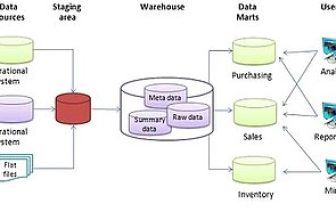Big data describes how businesses’ organized, unstructured, and semi-structured data is collected. This data can be mined and used in analytics applications such as predictive modeling, machine learning, and other forms of advanced analytics.
Data lakes and warehouses are some of the most common ways of storing huge volumes of data.
A data lake is a large storage medium that stores all an organization’s data, whether organized, unstructured or semi-structured. It is basically a large pool of raw data. On the other hand, a data warehouse only stores organized data from different operational and external sources.
This article looks at the similarities and differences between data warehouses and data lakes. Keep reading to find out who uses them and why.
What we cover
What is a Data Lake?
A data lake is a large data storage facility that stores all of an organization’s data, both structured and unstructured. You can think of it as a massive pool of raw data (in its natural state), like a lake.
A data lake can hold an unlimited amount of data because there’s no set limit for the size of a file or account, and there’s no established use. The data originates from multiple sources and includes organized unstructured and semi-structured data.
Organizations utilize data lakes when they need to collect large amounts of data without processing it immediately. Engineers and data scientists are the end consumers of data lakes.
Data lakes offer the following advantages:
- They give the organizations access to all the data at once.
- They eliminate the need to transport data.
- They make it possible to access data from different origins, possibly from different parts of the world.
- They accelerate delivery by allowing organizations to put up apps quickly.
That said, data lakes might cause problems with data quality. Sorting through the data in a data lake can be time-consuming and to manage integrity, the data lake needs frequent governance.
Examples of data lakes include cloud storage services like Amazon S3, Google cloud storage, or a distributed file system like Apache Hadoop.
What is a Data Warehouse?
A data warehouse, on the other hand, is a big collection of organizational data from several operational and external sources. This data has been processed for a certain purpose, and it is formatted, filtered, and organized.
Data warehouses gather processed data from different departments in an organization for sophisticated analytics and querying. They regularly gather data from various internal applications and systems of external partners.
Inter-departmental data sharing is common in medium and large enterprises. A data warehouse can help store data about inventory, employees, products, customers, orders, and more. Business users and entrepreneurs are the end consumers of data warehouses.
Some of the advantages of data warehouses are:
- They offer a significant processing capability.
- They boost the operational value of business systems, especially customer relations.
- They enable greater speed and flexibility.
Most organizations need to combine data from several subsystems to create good business intelligence. They achieve this using data warehousing, which compiles all the company’s processed data and stores it in one central location.
Another important benefit of data warehousing is straightforward audits. The purpose of an auditing process is to ensure that the data is factual, current, and accessible, which is also the aim of a data warehouse.
With that said, data warehouses necessitate ongoing cleansing, data integration, and transformation. Challenges may also arise during the implementation phase due to the objectives the organization wishes to pursue.
Examples of data warehousing tools include Oracle, Amazon Redshift, and Marklogic.
Similarities
The two data storage methods are similar in that:
Centralized Data Storage Locations
Data lakes and data warehouses are both centralized data storage locations. This means that they combine data from different sources into a single repository.
The only difference is that the data in data lakes includes organized, unstructured and semi-structured while all the data in data warehouses is processed and organized.
Structured Data
Data warehouses specifically store structured and processed data. However, data lakes store all types of data, including structured data.
As a result, structured data is stored both in data lakes and data warehouses.
Support for Cloud Storage
Both data lakes and warehouses support cloud storage. Data lakes like Google Cloud Storage are entirely cloud-based.
Similarly, data warehouses like Amazon Redshift are cloud-based solutions.
Differences
While data lakes and data warehouses are methods of storing massive data, they are not interchangeable terms.
Here are some of the biggest differences between them:
Data structure
Data lakes store raw data while data warehouses store processed, refined data. Raw data is data that hasn’t been processed for a specific purpose.
As a result, data warehouses typically take up more storage than data warehouses. In addition, unprocessed data is malleable, can be quickly processed, and is ideal for machine learning.
The downside is that data lakes often become swamps of data without data quality or data governance measures.
By storing processed data, data warehouses save on storage space, which can be pricey. Processed data is also easier to consume than raw data.
Processing Capability
Data is brought into data warehouses through the ETL (extract, transform load) procedure.
The data warehouses:
- Obtain data from its raw sources.
- Clean it up and model the data.
- Fill operational repositories with data.
In contrast, data lakes use the ELT method, which is more popular with unstructured data. The data lakes obtain the data from its raw sources. After analysis, a data analyst or architect transforms the data if required.
Accessibility
Accessibility refers to the data repository as a whole, not the data within it.
Data lakes have no structure, and therefore they’re easy to access and change. The changes made to data can also be done very quickly because data lakes have very few limitations.
On the other hand, data warehouses have more structure because the data within them is for fixed and predetermined purposes. This makes it harder to access or change.
Users
As we’ve already established, the data in data lakes and warehouses is aimed at different users. The majority of users in an organization are “operational.” They need access to reports, key performance indicators, queries, etc.
Since the data in data warehouses is well structured and easy to comprehend, it is ideal for these users.
The remaining users conduct an in-depth analysis using the data warehouse as a resource but often go back to the original source to retrieve data that isn’t in the warehouse.
A very small fraction of the users will be tasked with performing an in-depth data analysis. This means combining the available data sources to form new inquiries that need to be addressed.
These users, including engineers and data scientists, use cutting-edge analytic techniques and tools like predictive modeling and statistical analysis.
These experts mostly use data from the data lake for its massive and varied data set.
Data Timeline
When it comes to data timelines, data lakes can retain all data. This includes the data in use, as well as the data that might be used in the future. Past data is also stored, making it easy to go back and analyze it.
In the data warehouse architecture, only the data with a specific premeditated use is stored.
Adaptability
Data lakes store tons of data in its raw form for access by any user. Users can also access it in novel ways.
More data means more questions can be answered. This makes the data more adaptable.
In contrast, data warehouses take a long time to set up. During development, a lot of effort is focused on analyzing sources of data and how they can be used to meet the organization’s goals.
Although warehouses are designed to be as adaptable as they can, they take a lot of time and developer resources.
Storage Cost
Data lakes are mostly use-scalable, low-cost commodity servers which result in lower rates per gigabyte stored.
On the other hand, data warehouses are more costly because, in addition to their storage costs, they require additional computational resources to run analytical queries.
Pros and Cons Summary
| Data Lake | Data Warehouse | ||
| Pros | Cons | Pros | Cons |
| All data, regardless of its structure or source is stored | The data might be low quality due to the lack of organization | Data is more comprehensible | Costlier storage costs |
| Ideal for users who conduct deep analysis | Data might take time to sort through | Stored data is processed and filtered | Less adaptable |
| Cheaper storage costs | Needs frequent governance to maintain data integrity | Supports cloud-based solutions | Less accessible |
| More accessible | The data is only used by users with specialized skills and tools | High processing capability | Lower data preservation |
| The data is more adaptable | The data can be used by all users | ||
| Supports cloud storage | Provides data from different sources in a single repository | ||
| High data preservation |
Recommendation Based on Usage
Both data lakes and data warehouses are important mass storage methods. However, each method has a unique use case.
When Should You Use a Data Lake?
Data lakes are ideal for organizations that have a high volume of structured, unstructured, and semi-structured data.
For instance, in the healthcare industry, there are in-patient records, clinical data, inventory, etc., and insights are needed in real-time.
Data lakes improve healthcare analytics and have a faster turn-around time.
When Should You Use a Data Warehouse?
There are four main reasons to get a data warehouse:
- If you need to analyze data from different sources.
- If your original data source is not suitable for querying.
- If you need to separate your analytical from transactional data.
- To improve the performance of your most used queries.
FAQs
Can a Data Lake Feed a Data Warehouse?
Yes. Since data lakes store all types of data, structured data stored in a data lake can easily be loaded into a data warehouse.
Can Data Lake Replace Data Warehouse?
Thanks to the ability to transfer data from data warehouses to cloud-based data lakes, the latter can replace the former. However, replatforming can be overwhelming for users. It’s therefore important to execute the migration in stages.
Can You Have a Data Warehouse in a Data Lake?
Yes. It’s possible to have a data warehouse within a data lake. Since data lakes have little storage and data type limitations, they can store data warehouses (which are just a collection of structured data.)
Why Is Data Lake Cheaper Than Data Warehouse?
Data lakes are cheaper because they are mostly scalable, low-cost commodity servers or cloud-first object storage. This results in the cost per gigabyte of storage.
Further, data warehouses need more computational resources on top of their storage costs to run analytical queries.






